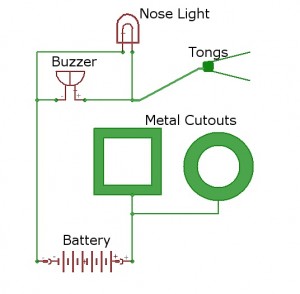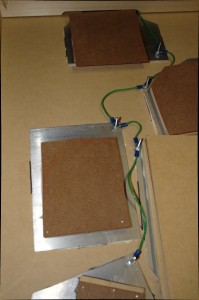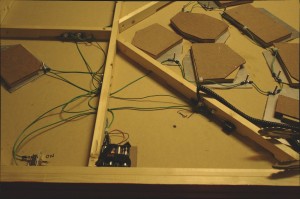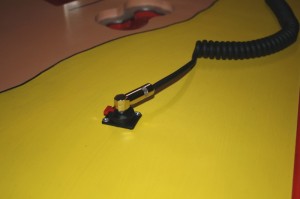I built this life-sized Operation Game for our churchs annual carnival. Here it is in action:
How it Works
Electronically the game is very simple. When the forceps (salad tongs in this case) touch the metal edges within the holes, it completes a circuit that has a light bulb and a buzzer on the other end. Like so:

The Build Process
I wanted to base my Operation Game on the original one that I grew up with … with the addition of some boxers for modisty. The only big difference is that I added a second set of forcepts so that two people could play at the same time with one on either side.
Scaling the Operation guy to be slighly over six feet tall gave me the dimensions of the game and the sizes of the removable pieces. The build them proceeded as follows (There are pictures below):
- Start by cutting out the main top board. I used 1/2 inch MDF.
- Create the patterns for the removable pieces (Google image seach horse lineart for example)
- Create a pattern for the deck cutouts. Mine are an inch larger than the piece they hold.
- Create a pattern for the metal cutouts. Mine are 1/2 inch larger than the piece they surround.
- Use the desk cutout patterns to cut templates from scrap pieces of wood.
- Arrange the template on the deck board to get the desired arrangement and spacing.
- Use double sided tape on the templates to attach them to the deck board.
- Using a flush trim bit on a router,cut all of the openings using the templates as a guide. Make sure to wear a mask because MDF dust is just nasty.
- Cut out your metal surrounds. I used 3/16 aluminum. I cheated and used a CNC machine to cut these, but honestly they could just as easily be cut with a jigsaw
- Sand and file everything smooth.
- On the outer edge of each metal piece, drill a small hole and feed a small bolt up through it. This will be used to connect your wires later on.
- Glue the metal surrounds onto the backside of your deck board.
- Glue your template to the back of the metal. This creates a box for the piece.
- Use some thin stock (I used hardboard) to create a bottom on each hole.
- I used 1 x 2’s to create a frame around and across the back of the deck board to given it some strength and to give it something to lay on.
- Install your battery pack, on/off switch if needed, light and buzzer.
- Install your wiring as in the diagram above. I used small nuts, bolts and ring terminals.
- When it’s all working, it’s time for paint. My wife and daughter painted this one up and then I hit it with several coats of clear to help protect it.
- Install your forcepts (salad tongs connected with telephone cords).
- Sit back and enjoy it!
The Results
This game was fun to build, but it was even more fun to see peoples reactions. It has survived two years of miscellaneous church and school functions with no problems other that a little scuffed paint.
——————————
Update August 2013
——————————
After several outings it was obvious that having the forceps permanently attached was a pain when transporting the game around. Also one of the phone cords got stretched out thanks to some over-active kids. In order to address both of these issues I installed locking 1/4″ jacks in the playfield and ditched the phone cords for expanding 1/4″ instrument cables. Now the forceps are easily removable.







